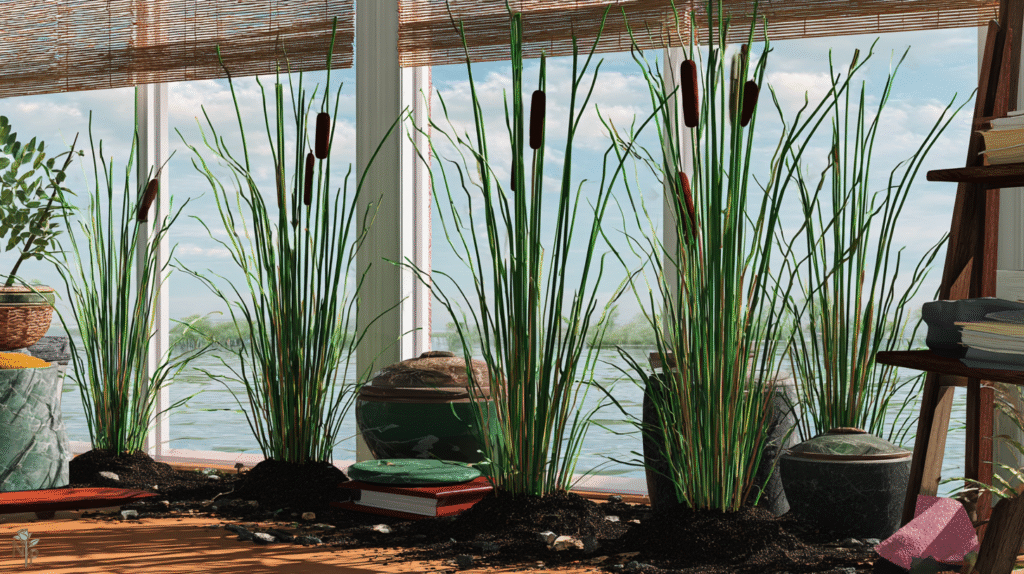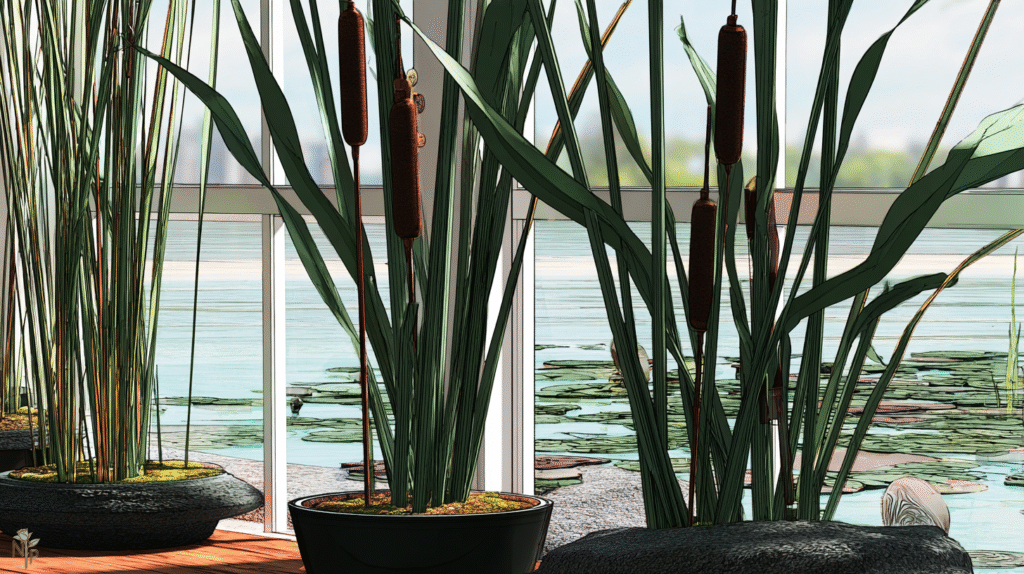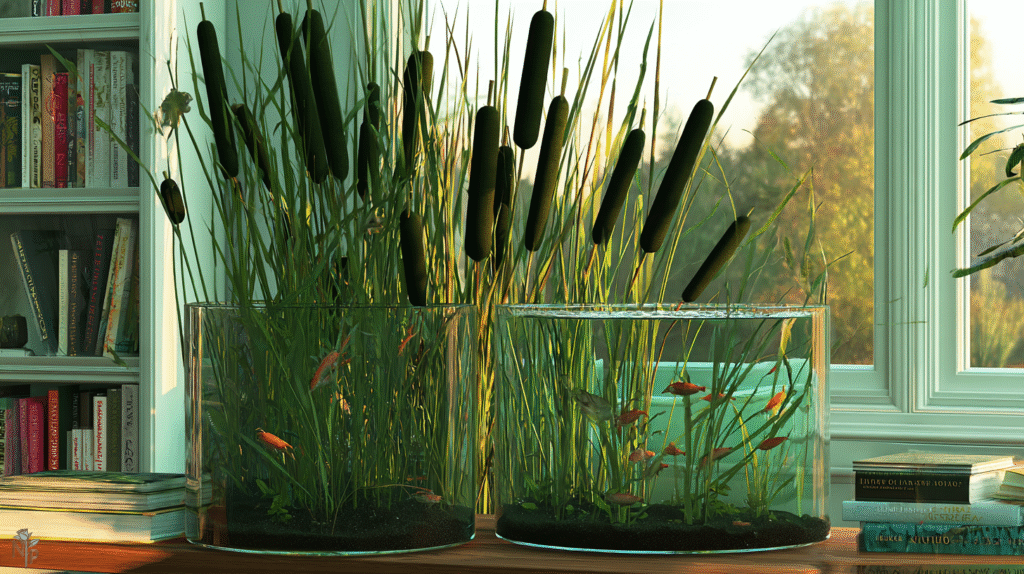My first cat tail plant came with instructions saying “keep moist and fertilize monthly.” Seemed simple enough. Three weeks later, it looked like someone had torched it with a blowtorch. Brown, crispy, dead.
Turns out “keep moist” for a cat tail plant means something completely different than for any other houseplant. These aren’t houseplants pretending to be pond plants – they ARE pond plants pretending they can survive in your living room. And that monthly fertilizing advice? Nearly burned the roots off my second attempt.
Four dead cat tails and about $120 later (these aren’t cheap when you keep killing them), I finally have three thriving plants. One’s over 6 feet tall and trying to puncture my ceiling. Another actually bloomed indoors, which the nursery guy said was “unlikely.” Here’s what nobody explains about keeping these swamp monsters properly watered and fed.

Understanding Cat Tail Water Requirements
They Want to Be IN Water, Not Just Watered
This was my biggest revelation. Cat tails don’t want to be watered like houseplants. They want their roots sitting in actual standing water 24/7. I know that sounds like root rot waiting to happen, but these are bog plants. Standing water is their happy place.
My setup now:
- Regular pot with drainage holes
- Sitting inside a larger pot with no holes
- 2-3 inches of standing water always
- Never, ever let it dry out
First time I tried this, I was convinced I’d wake up to root rot. Instead, my dying cat tail pushed out three new shoots in a week.
Water Quality Makes a Huge Difference
Cat tails are surprisingly picky about water quality for swamp plants. My tap water is harder than a rock (450 ppm dissolved solids) and they hated it. Brown tips everywhere, slow growth, general sadness.
What works:
- Distilled water (best but expensive at $4/week for three plants)
- Rainwater (free but I live in Phoenix so… twice a year)
- Filtered water (good compromise)
- Tap water aged 48 hours (okay-ish, chlorine evaporates but minerals don’t)
Switched to filtered water and the difference was obvious within a month. New growth came in pure green instead of pre-browned.
Seasonal Water Needs
Summer cat tails are thirsty monsters. Mine drink so much I’m refilling their water reservoirs every 2 days. The 6-footer can empty 3 inches of water in 48 hours when it’s actively growing. It’s like having a very boring pet that only drinks.
Winter is different:
- Still keep water in the tray but only 1 inch
- Refill weekly instead of every 2 days
- Too much standing water in winter when they’re dormant = crown rot
Learned the winter thing after losing one to mushy crown in January. Now I reduce water levels December through February.
The Feeding Schedule That Actually Works
Why Standard Fertilizer Burns Them
The nursery tag said “fertilize monthly with balanced fertilizer.” Did that. Leaves got brown edges, then brown patches, then dead. Turns out cat tails are adapted to nutrient-poor bog conditions. Standard houseplant fertilizer is like feeding them rocket fuel.
What actually works:
- Quarter strength liquid fertilizer (not half, not full – QUARTER)
- 10-10-10 or 20-20-20, doesn’t matter much
- Every 2-3 weeks in growing season
- Nothing December through February
My current mix: 1/4 teaspoon per gallon when package says 1 tablespoon. Yes, that diluted.
The Slow-Release Pellet Experiment
Tried slow-release pellets thinking it would be easier. Big mistake. Can’t control the concentration, created hot spots in the soil, burned roots on one side of the plant. Stick with liquid you can dilute.
Signs You’re Overfeeding
- Brown leaf tips (but also could be water quality)
- Brown patches in middle of leaves (definitely fertilizer burn)
- Dark green leaves but no new growth (too much nitrogen)
- White crusty buildup on soil (salt accumulation)
My rule now: when in doubt, skip feeding. Underfed cat tails grow slowly. Overfed ones die dramatically.

Creating the Perfect Growing Medium
Soil Mix for Containers
Regular potting soil = death. Too light, doesn’t hold enough water, doesn’t replicate bog conditions. After killing two plants in regular soil, I developed this mix:
- 40% cheap topsoil (the heavy stuff)
- 30% peat moss or coco coir
- 20% sand (not play sand – coarse sand)
- 10% compost
It’s basically mud when wet. Perfect. Holds water like crazy, stays heavy, doesn’t float when sitting in water.
The Pond Basket Method
Best discovery ever: pond planting baskets from the aquarium store. They’re plastic mesh baskets meant for water plants. Soil stays in, water flows through freely. Game-changer for cat tails.
Plant in pond basket with heavy soil mix, place in decorative pot with water. Looks nice, works perfectly, cat tail thinks it’s in a pond.
Why Regular Pots Fail
Normal pots with drainage holes sitting in water trays create weird moisture gradients. Top dry, bottom swampy, middle confused. Cat tails want consistently saturated soil throughout. Pond baskets or undrained containers work better.
Container Depth and Size Matters
They Need Deep Containers
Cat tails have massive root systems. Killed my first one in a shallow 6-inch decorative pot. The roots hit bottom in a month and started circling. Plant stopped growing, started dying.
Minimum depths:
- Small varieties: 10 inches
- Standard varieties: 12-14 inches
- Giants (like my ceiling-poker): 16+ inches
Width matters less than depth, but wider = more shoots = fuller plant.
The Repotting Nightmare
Cat tails grow rhizomes (horizontal underground stems) that become absolutely massive. My 6-footer’s rhizome is thicker than a broom handle. Repotting involves:
- Cutting the pot if it’s plastic (seriously)
- Root saw for dividing (kitchen knife isn’t enough)
- Accepting you’ll damage some roots
- Having new pots ready because one plant becomes three
Last repotting looked like plant surgery. Took two hours. Cat tail didn’t care, grew 8 inches the next month.
Troubleshooting Water and Feed Issues
Brown Tips But Everything Seems Right
This drove me insane for months. Perfect water, minimal fertilizer, still brown tips. Solution: humidity. Cat tails want 60%+ humidity. My house in winter: 25%.
Added a humidifier near them, brown tips stopped. They’re bog plants – they want bog air too.
Yellowing Leaves
- Old leaves: Normal, remove them
- All leaves: Needs fertilizer (but diluted!)
- New leaves: Too much water in winter or crown rot starting
Slow or No Growth
Check in order:
- Is there enough water in the reservoir?
- When did you last fertilize? (Might need food)
- How long since repotting? (Might be rootbound)
- Is it winter? (They barely grow in winter)
My cat tails grow 6 inches monthly in summer, nothing December-February. Thought something was wrong first winter. Nope, just dormant.
My Current Setup
The Monster in the Living Room
- 14-inch deep pot in 16-inch decorative container
- 3 inches of distilled water always
- Fed every 2 weeks April-September with super diluted fertilizer
- Hasn’t been repotted in 2 years (dreading it)
- 6+ feet tall and producing babies
The Bathroom Experiment
- In pond basket sitting in ceramic pot
- Filtered water from the sink (convenient)
- Fed monthly because bathroom humidity compensates
- Grows faster than living room one despite less light
The Outdoor Transition Failure
Tried moving one outside for summer thinking it would love “natural” conditions. Phoenix sun murdered it in three days. Even bog plants have limits. Indoor only now.
Feeding Schedules Through the Seasons
Spring Awakening (March-April)
Start feeding when you see new shoots appearing. First feeding at 1/8 strength to wake them up gently. Increase to 1/4 strength by April. This is when they’re hungriest.
Summer Feast (May-September)
Peak growing season. Feed every 2 weeks with 1/4 strength fertilizer. Keep water levels at maximum (3-4 inches). They’re growing machines during this period.
Fall Slowdown (October-November)
Reduce feeding to once monthly. Lower water levels to 2 inches. They’re preparing for dormancy. Too much food now gets stored and can burn roots over winter.
Winter Rest (December-February)
No fertilizer at all. Maintain 1 inch of water only. They look terrible – yellowing leaves, no growth. This is normal. Resist urge to fertilize. First year I panic-fed in January, gave it root burn.

The Bottom Line
Cat tails are easy once you understand they’re not houseplants – they’re pond plants. They want:
- Roots sitting in water always (2-3 inches minimum)
- Filtered or distilled water if your tap is hard
- Very diluted fertilizer (1/4 strength) during growing season only
- Heavy, muddy soil that stays wet
- Deep pots for massive root systems
Get these right and they grow like weeds. Get them wrong and they die faster than ice cream in Phoenix.
My cat tails went from crispy brown disasters to jungle monsters once I stopped treating them like houseplants and started treating them like the swamp things they are. Now my biggest problem is they’re outgrowing my ceiling. Good problem to have after killing four of them.






